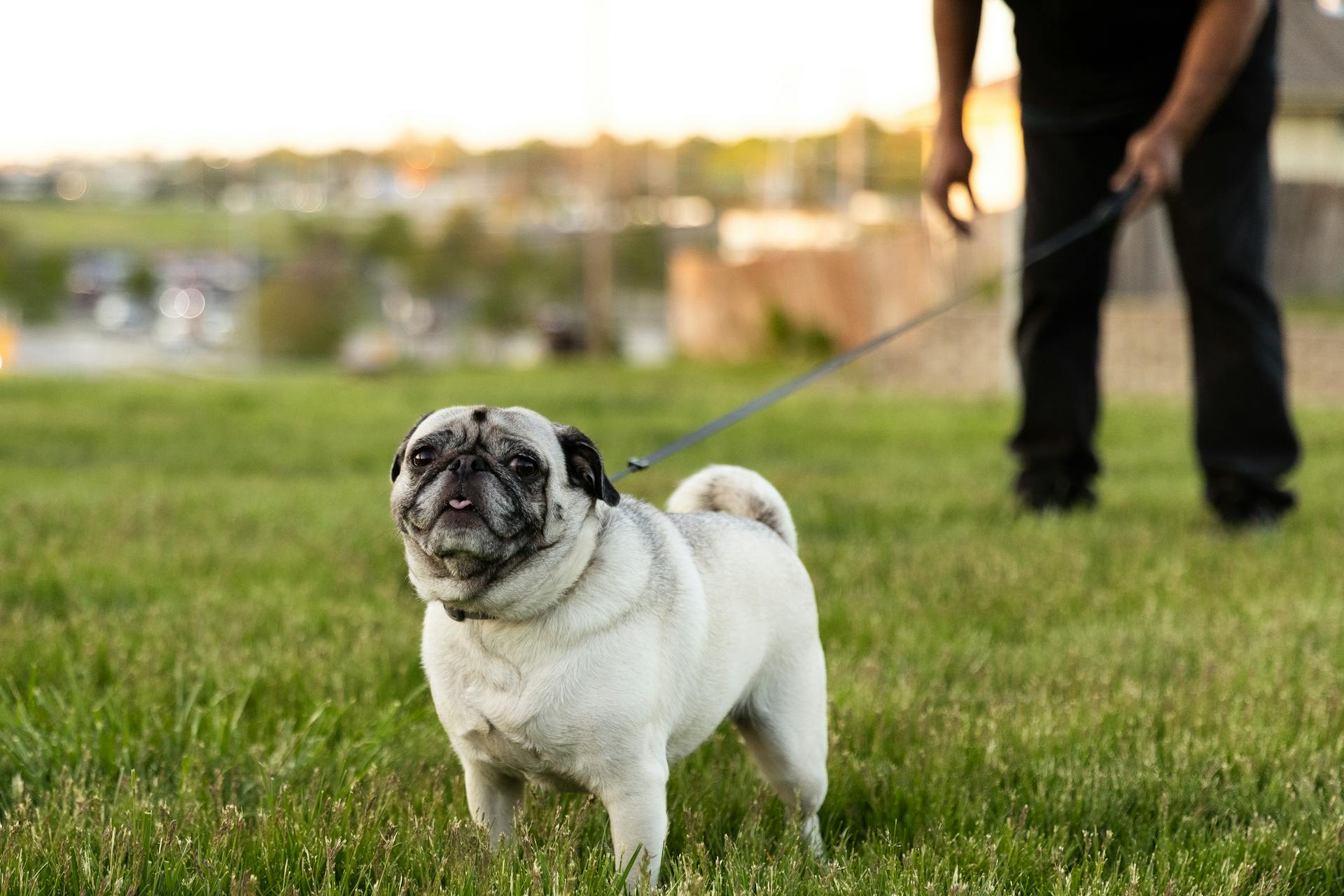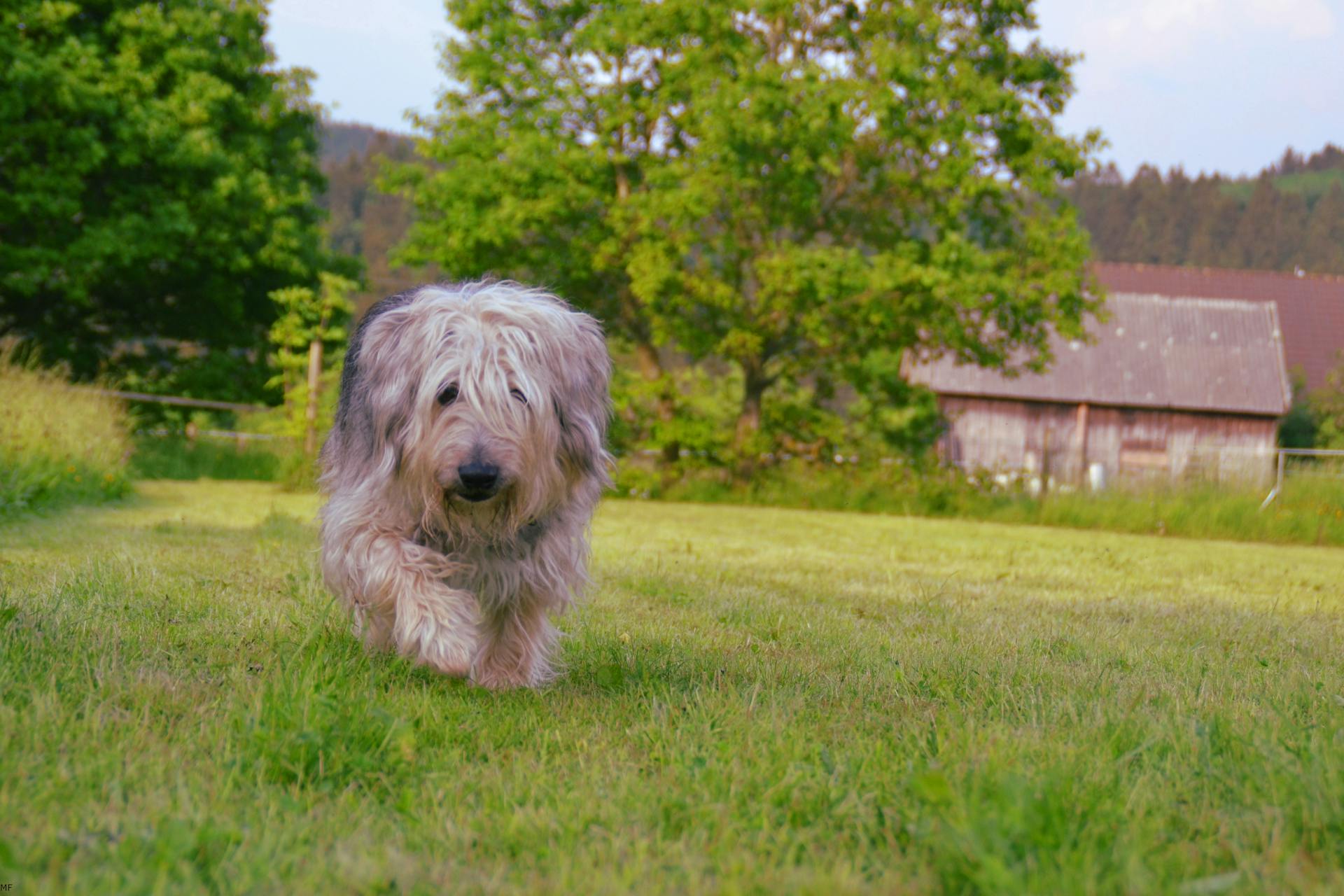
Pugs have been a popular family pet for centuries, and it's easy to see why. They're small, playful, and loving dogs that thrive on human interaction.
Pugs are adaptable to living in small spaces, making them perfect for city dwellers or families with limited yard space. They require moderate exercise, but a short daily walk and some playtime indoors can keep them happy and healthy.
Pugs are also relatively low-maintenance when it comes to grooming. They have a short, smooth coat that requires only occasional brushing and bathing. This makes them a great choice for busy families who don't have a lot of time to devote to dog grooming.
Suggestion: Smartest Small Dog Breeds
Training and Socialization
Training a pug requires patience and consistency. Pugs are easily trainable, but they can be stubborn at times, making it essential to use positive reinforcement techniques.
Socialization is also crucial for pugs, especially when it comes to interacting with children. A well-socialized pug is more likely to be comfortable and well-behaved around kids.
Pugs respond well to positive reinforcement training methods, which makes them a great breed for families with kids. Basic obedience and socialization are essential for a child-friendly pug.
To socialize your pug, expose it to children in controlled, positive environments, and use treats and praise to reward calm and friendly behavior. Regular, gentle exposure to various social situations involving children can also help.
Pugs can learn a variety of tricks using positive reinforcement training, which will allow your pug to learn that positive techniques happen when they do something good. Break the training of your pug into goals to ensure a simple transition to setting your puppy up for success.
Here are some essential training goals for pugs:
- Teach your puppy to know their name
- House train your pug
- Socialize your puppy to animals, people, places, and situations
- Teach basic commands like "watch me", "sit", and "stay"
- Teach your pug to behave gently around children
Remember, consistency and patience are key when training a pug. With positive reinforcement techniques and gentle exposure to various social situations, your pug will become a well-behaved and loving member of your family.
Expand your knowledge: Dogs Breeds That Start with B
Health and Grooming
Pugs require regular veterinary check-ups to maintain their health, and families should be prepared to manage specific health issues such as respiratory problems and skin allergies.
Pugs are prone to respiratory problems due to their brachycephalic nature, and owners should be aware of the signs and symptoms of breathing issues, including snoring and snorting.
Regular grooming is essential for Pugs, including weekly brushing with a soft-bristle brush, and paying particular attention to skin folds and wrinkles to prevent moisture buildup and skin yeast infections.
Pugs shed a lot of hair, and owners should be prepared for regular cleaning and vacuuming to manage the shedding. Here's a quick checklist for Pug grooming:
- Brush your Pug weekly with a soft-bristle brush
- Bathe your Pug as needed, and dry them thoroughly to prevent skin issues
- Check their ears and eyes regularly for signs of infection
- Trim their nails and provide regular dental care
Health Issues
Pugs are prone to many health problems, including ear, eye, and skin infections and breathing problems. Regular ear cleanings and bathing can help prevent some of these issues.
Pugs need frequent trips to the veterinarian due to their health concerns. Invest in nutritionally balanced and healthy dog food to keep their weight in check.
Respiratory issues are a common health problem in pugs, caused by their brachycephalic (flat-faced) nature. Regular vet check-ups are crucial to monitor their health.
Frequent vet visits can also help prevent bone and joint problems, skin disorders, and eye infections that pugs are prone to.
Curious to learn more? Check out: Embark Dog Dna Test Breed & Health Kit Stores
Grooming Your
Grooming your pug requires regular attention to prevent skin issues and keep them clean. Pugs need daily brushing to manage their thick double coat, which sheds frequently and holds odors.
Their skin folds can quickly develop a buildup of debris and moisture, leading to skin yeast infections, dry skin, and dirty ears. So, it's essential to clean around the nose and wrinkles regularly.
Daily brushing is a good start to taming the shedding and making it manageable. A soft bristle brush is perfect for this task, and it also feels good for your pug, making them feel relaxed and happy.
Pugs don't need regular bathing, but if you do bathe them, make sure to dry them thoroughly, paying particular attention to skin folds and wrinkles. Trapped moisture can lead to sores if left unchecked.
Here are some key grooming tasks to keep in mind:
- Brush your pug daily with a soft bristle brush.
- Bathe your pug occasionally and dry them thoroughly, especially around skin folds and wrinkles.
- Check their ears for signs of infection, such as black or brown ear wax or a strange smell.
- Check their eyes for weepiness and their body for lumps and bumps, and signs of parasites.
Temperament and Size
Pugs are renowned for their friendly and affectionate nature, making them a great choice for families with children. They are typically sociable dogs who enjoy being around people, including kids.
Their playful and sometimes comical behavior can be a great source of amusement and companionship for kids. Pugs are also known for their gentle disposition, which is a crucial trait when considering a pet for a family with children.
However, like all dogs, Pugs have their own set of needs and temperament traits. They can be quite sensitive and may require a calm and gentle approach, which is an important consideration for families with very young or overly energetic children.
Pugs are members of the toy group, with a range in height from 10 to 11 inches and a range in weight from 14 to 18 pounds. Their small size makes them less intimidating for kids and easier for them to interact with.
Their size also means less risk of accidentally knocking over or harming small children during play. However, their size can also be a concern, as they can still be injured by rough play or accidental mishandling.
Here are some key size and temperament traits to consider:
Pugs are out-and-out extroverts who love people and being the centre of attention. They easily adapt to different living environments, from busy family homes to quiet single owner households.
Their friendly and playful nature, along with their small size, makes them ideal playmates for children. However, like any breed, they should be supervised with children at all times.
Family and Children
Pugs are generally great with children due to their gentle and affectionate nature. They enjoy being part of a family and can form strong bonds with kids.
A Pug's temperament is ideal for kids, as they are friendly and loving, thriving in the company of humans, including children. They are generally gentle and playful, even-tempered, making them excellent companions for kids.
Pugs are not typically known for being protective or guard dogs, but they can develop a strong bond with their family members and may show alertness to new or unusual situations involving their family members.
Teaching children how to handle Pugs gently is essential to prevent accidental injuries, and it's also important to supervise interactions between children and Pugs to ensure the safety and comfort of both the child and the dog.
A comfortable Pug will display relaxed body language around children, may seek out interaction and play, and will not shy away from gentle petting. Signs of comfort include a wagging tail, relaxed ears, and a willingness to stay close to the child.
On a similar theme: Gentle Giant Dog Breeds
Socialization plays a pivotal role in how well a Pug gets along with kids, and exposing them to various situations, people, and other pets, including children, can help ensure they are well-adjusted and confident.
Supervising interactions between children and Pugs is critical to ensuring the safety of both the child and the dog, and teaching children how to interact with Pugs safely, emphasizing gentle petting and respecting the dog's space, is also essential.
Responsibility and Care
Teaching your child to interact with your Pug safely is crucial to ensure the well-being of both the child and the dog. Supervision during interactions is critical.
To start, educate your child on interacting with the Pug gently and respecting the dog's space. This includes not disturbing the Pug while it's eating, sleeping, or in its safe space.
Regular veterinary check-ups and maintaining a healthy weight are crucial for keeping your Pug healthy and comfortable. Pugs are prone to specific health issues, including respiratory problems due to their brachycephalic nature.
Responsible Ownership
Owning a Pug requires a commitment to their daily needs, including exercise, mental stimulation, and grooming. They thrive in environments where they're part of family activities.
Pugs shouldn't be left alone for long periods, as they can get anxious and stressed. Regular veterinary check-ups are essential to monitor their health.
Teaching children about pet care and the specific needs of Pugs can be a valuable lesson in empathy and responsibility. It's crucial to supervise interactions between children and Pugs to ensure they're positive and stress-free.
To eliminate health risks, it's best to go to a good breeder who can provide healthy puppies. Regular vet check-ups and a healthy diet can help prevent respiratory problems and skin allergies.
Introducing a Pug to children should be done in a calm and controlled environment, allowing the Pug to approach them on its own terms. Supervising these interactions is essential to ensure they're positive and stress-free for both the Pug and the children.
Expand your knowledge: Is Grain Free Dog Food Better for Dogs
Top Fresh Dog Food Brands
As a responsible dog owner, choosing the right food for your Pug is crucial for their health. Fresh dog food brands offer a range of benefits for Pugs, including improved digestion and reduced allergies.
The best fresh dog food brands for Pugs might help keep your pup healthy. Some of these brands provide pre-portioned meals that make feeding time easier and more convenient.
Pugs need a balanced diet that meets their specific nutritional needs. Fresh dog food brands cater to these needs by using high-quality ingredients and avoiding fillers and by-products.
Fresh dog food can help reduce the risk of obesity and other health problems in Pugs. By choosing a reputable brand, you can ensure your Pug is getting the nutrients they need to thrive.
Some popular fresh dog food brands for Pugs include Ollie and The Farmer's Dog. These brands offer customized meal plans and high-quality ingredients that meet the unique needs of Pugs.
Additional reading: Dog Breeds That Don't Need Grooming
Frequently Asked Questions
Are pugs good for home dogs?
Yes, pugs make great home dogs due to their adaptable nature and friendly temperament. They are ideal for families and individuals alike, making them a popular pet choice.
What are the disadvantages of having a pug?
Pugs can be prone to health issues and require regular grooming due to their unique characteristics. They also have specific needs that may not be suitable for all owners, such as frequent veterinary visits and regular exercise.
Featured Images: pexels.com


